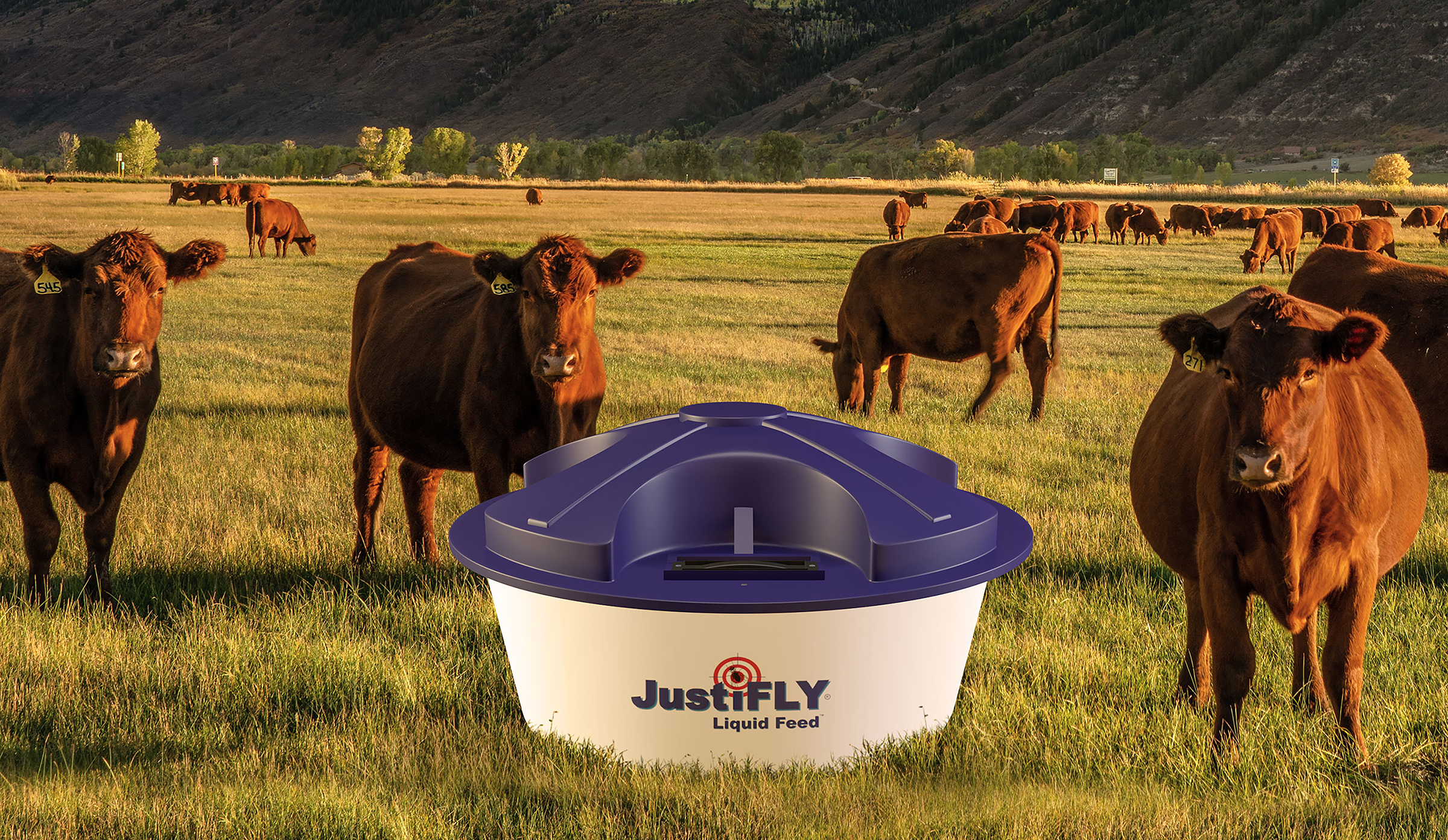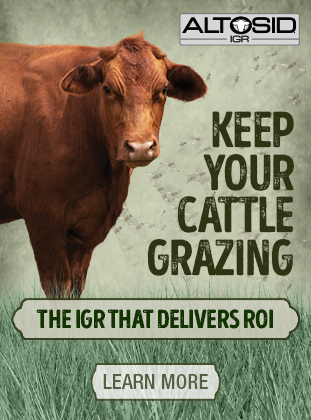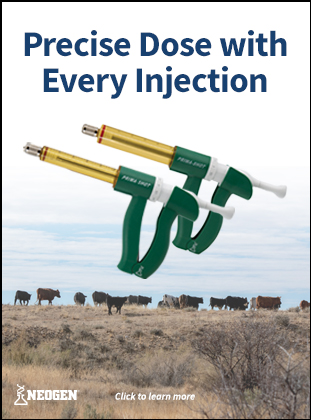Maintaining Control with Fly Populations

Maintaining Control with Fly Populations
Article and photos courtesy of Champion Animal Health
When it comes to the health and wellness issues that producers need to monitor to keep their livestock in good condition and their bottom line intact, fly control is one of the biggest issues. Here’s why: Not only do fly species transmit more than 60 diseases from animal to animal, but heavy infestations of certain types of flies, can also result in significant blood loss, stress, and weight loss.
“The biggest impact flies have on cattle is stress,” says Andre Rocha, President of Champion Animal Health. Cattle should be laying around, relaxing and gaining weight. Fly bites are painful. To get away from flies, cattle walk, they stomp, they swat, they throw their heads, they worry.” In addition, as Rocha explains, mama cows produce 15-20% less milk when stressed, which results in less gain for the calves. When cattle are living stress-free lives, they graze, they rest. It comes down to relaxed cows gaining more weight, and putting more dollars in the cattleman’s pocket. Controlling flies decreases stress, allowing more weight gain which, in turn, allows more profit.
Originally founded in Brazil, Champion Animal Health entered the United States marketplace in 2016, much to the satisfaction of ranchers and farmers across the country. The company celebrates a rich 70-year history that not only includes animal health product development, but also involvement as ranch owners and producers in the livestock market, owning thousands of acres and thousands of head of cattle. This means the Champion team truly understands animal health and behavior.
Eight years after entering the U.S. marketplace, Champion USA continues the vision of bringing the highest-quality products into the livestock market for distribution while it supplies the animal production chain with products that lead to profitability. One such fly control product, JustiFLY®, is turning out to be a game changer in the area of fly control within the cattle industry. In fact, Champion Brazil was the first company in the world to use diflubenzuron – the active ingredient in JustiFLY® – as fly control for the cattle market.
At its core, JustiFLY® is an insect growth regulator (IGR) that controls all four flies that affect cattle, including the horn fly, stable fly, house fly and face fly. Many IGRs on the market cover only the horn fly, which is the species typically seen on pasture cattle.
But as Rocha explains, for producers that feed cattle in pens or feed round bales, the stable fly will be the most impactful to their cattle, causing pain and stress to the animals.
“When you see cattle stomping, then they are being bothered by stable flies,” Rocha says. “The same goes for the house fly and face fly. Those two flies get missed in some of the other IGRs.”
So what makes JustiFLY® stand out in the field of fly control products? For starters, Champion’s fly control requires zero cattle handling. This means no gathering, penning, spraying, ear tagging, stressing cattle, etc. It comes in a delivery system that cattle are already using – specifically, mineral, blocks or feed.
In addition, the product is dung beetle friendly. Beneficial insects like the dung beetle are important for the natural balance of pasture and soil.
“There’s also no withdrawal period for slaughter animals or milk disposal time for dairy cattle that have been on JustiFLY®,” Rocha says. “It’s a very safe product. It is even recognized as safe for natural beef programs through IMI Global’s Where Food Comes From. And JustiFLY’s feedthrough IGR fly control, which has proven to have no pest resistance that is commonly experienced with ear tags or sprays, interrupts the life cycle during molting. This results in the insect’s inability to develop resistance.
“All of the JustiFLY® products use IGR technology,” Rocha says. “With most of the products being a feedthrough, the effectiveness happens in the manure. Cattle ingest the product by eating mineral, blocks, or feed that has been treated with JustiFLY®. It goes directly through the animal and into the manure where it becomes active. Fly larvae feed on the microbes in manure and ingest the larvicide. They molt into pupae, but the chitin inhibitor in JustiFLY® doesn’t let the larvae hatch into healthy adults. The life cycle ends there.”
Champion recognizes that cattle ranches and farms vary in size and complexity. That’s why the company offers several options for larvicide delivery in their fly control product segment. The most popular product is the JustiFLY® Feedthrough 3% in the small add pack size, proportioned to be mixed with a 50-lb bag of free-choice mineral.
As Rocha explains, cattlemen simply pour in the add pack and mix it into the mineral. It is also sold in larger bags of the same product, for larger operations. Cattle will ingest it as they feed on the mineral.
For on-site mixing into TMR, most operations prefer the JustiFLY® 0.67% Premix. Champion also offers a liquid feed additive option to be added to liquid feed tanks upon charging that gives the same opportunity for fly control. Cattle ingest the product as they lick on the liquid feed. The company’s Fly-A-Salt® blocks, a salt block treated with the IGR fly control, is the simplest way to feed the product.
“This last winter, we brought JustiFLY® Pour-On 5-5 to the market that is a combination of 5% permethrin and 5% diflubenzuron. The most popular use for the pour on is for lice treatment,” Rocha says. “The permethrin kills what is on the cattle at the moment, then the diflubenzuron works on the nits to end the life cycle. And of course, it works on immediately treating flies on the animal.”
Most recently this spring, Champion launched its horse product, JustiFLY® Equine 8-8-8. It is a top dress that is fed daily to get the same benefits of controlling the next generation of flies for horse owners. Small blocks for horses will be released later this year.
So what are some key ways that cattle producers can establish a solid fly control program? Start by recognizing that there are four distinct fly species that affect cattle – something many cattle producers don’t realize.
“Each fly species prefers a specific environment to thrive. The more producers understand what they are dealing with, the better they can control their fly population,” Rocha says. “Feedthrough IGR fly control is such an easy and effective method to deal with fly problems, but there are many IGRs on the market. Producers need to make sure they are using the right one for their operation.”
For example, using an IGR that only treats a horn fly, does work…on the horn fly. But it may not seem to be working when the cattle continue to have stable flies and house flies all over them. And with the stable fly being the most economically impactful, it needs to be one that is covered in a producer’s chosen fly control product.
In addition, with fly control – all cattle need to be treated, not just one pen or pasture.
“Flies travel. And it takes teamwork. If you are doing all the fly control and your neighbor across the fence does none, his flies are going to fly over to your cows and bother them,” Rocha says.
Do you have questions about which JustiFLY® product is ideal for your specific operation? Champion Animal Health’s customer support line is a resource customers can use to discuss and choose the best product.
“Folks always seem to need information on feedthrough, especially first-time users,” Rocha says. “We are available to answer questions and come up with solutions.” To learn more visit www.championanimalhealth.us.



